#ポリスキーパー
Explore tagged Tumblr posts
Text
Tiny Titan Microman: the “Lost Adventures” - Year Three (1978)
(Continued from Year Two - see Year One for more details and credits. Special thanks this posting to GanguStars.com and the original “Microman Trivia” transcription translated from the amazing Tette Hakase at Alpha-7 Laboratory)
Chapter 24: January, 1978
The model for the CosmoCountach* is of course the Lamborghini Countach LP400. Ann, a Lady Command who loves machines, had begged Microman Takuma to build one for her.
The rear portion of the CosmoCountach houses the computer brain of a robot inside it. It can separate to function independently of the Countach, as well as transform into A*, B*, and C* types of robot-cars depending on the situation. ((* image links via MicroEarth website))
Chapter 25: February, 1978
This month, let’s introduce the Microman Commands who have appeared in Japan and have since become active. The leader of the four is serial number M-171 “Takuma.” He was revived in October of 1977 from a clay figure unearthed from ruins in Kamegaoka, Aomori Prefecture, and has an extensive memory of space science data.
M-172 Tetsuya was similarly revived in October of 1977 by a beam from Surveyor 1 that had scanned the Saibana ruins at Mount Osore in Aomori. A historian, his knowledge of ancient ruins in Japan is unmatched, thanks mostly to his having been there at the time.
((Tette Hakase: It apparently goes without saying that he also knows the history of MicroEarth itself in detail.))
M-173 Tatsuya was revived in that same October, 1977 from inside a buried stone that was part of the Ooyu stone circles in Akita Prefecture. A historian, his knowledge of ancient ruins in Japan is unmatched, thanks mostly to his having been there at the time.
((Tette Hakase: An editorial mistake copied the same data as Tetsuya’s. According to “Microman Book,” Tatsuya’s brain is filled with data from energy research.)
M-173 Tsuyoshi, also found in October, at the Futatsumori buried shell midden ruins in Aomori. Unrivaled in his knowledge of plants and trees, he has the brain of a brilliant biologist, particularly specialized in botany.
Chapter 26: March, 1978
MicroEarth, the homeworld of Microman, exploded several thousands of years ago. The people of MicroEarth were humanoids that were nearly identical to Earthlings and their abilities. So why did they become cyborgs?
The Micromen on Earth today are referred to as cyborgs due to the mechanized portions of their bodies. The inhabitants of MicroEarth had modified their bodies to become cybernetic organisms in order to survive on other worlds after their emigration to outer space following the explosion. ((Tette Hakase: According to Magazine Zero Zero, only the initial cyber-implants were performed on MicroEarth. It seems that they became full-body cyborgs at the time of their revival from their crystals.))
However, while the people on MicroEarth were becoming the cyborgs that would become Micromen, this opportunity did not arise for those who were off-world in space colonies and on space patrols.
Even so, they were beings similar to humans, which meant that unless they wore extra-vehicular gear (Hoods), they could not survive in the airless vacuum of space. As such, they are distinguished from Micromen as Hoodmen, and are just now reaching Earth.
Chapter 27: April, 1978
After the explosion of MicroEarth, the vast starship “Noah” which carried hundreds of Micronian refugees continued to wander through the cosmos. They remodeled the Noah into a grand colony-ship, where life could continue unhindered as they further researched αH7.
In addition, the manufacture of small craft began that could leave the Noah mothership to venture further into space and to other worlds. Ten models were created, such as the HoodLiner, HoodGyro, HoodCart, HoodCessna, and HoodRacer.
Also, unlike the Micromen who survived through becoming cyborgs, the flesh-and-blood Hoodmen developed a special spacesuit suited to surviving and improving life in outer space. This is what is called the “Hood.” Capabilities of the Hood: (1) oxygen generator, (2) energy amplifier, (3) antigravity device, (4) infrared windscreen, (5) laser launcher, (6) energy shield , (7) radar, (8) αH7 shield—with this, the Hoodman’s abilities could be even greater than that of a Microman.
Chapter 28: May, 1978
Kit Machine No.1 HoodLiner: flies through space converting cosmic radiation into energy with a “Cosmic Wave Motion Engine.” Its sole armament is a magnetic force beam, but is equipped with a radar device which can detect moving objects and lifeforms within 3,000 kilometers.
Kit Machine No.2 HoodGyro : equipped with a special engine called the “Land Fiber Engine”, it flies using a large Ion Propulsion propeller. Superior in maintaining stability, it is suitable for lower speed missions.
Kit Machine No.3 HoodCart: featuring high speed flight using a Hood Turbo Engine. Its deluxe power tires give it a high operating speed of 1200 kilometers per hour and is equipped with a built-in rapid-response photonic radar.
Kit Machine No.4 HoodCessna: a multipurpose vehicle capable of both high speed flight with a Hood Turbo Engine as well as lower speed maneuvers with an Ion Propulsion propeller. It is armed with a single magnetic force beam weapon.
Chapter 29: June, 1978
Kit Machine No.5 HoodRacer: propelled by a Hood Turbo Engine, with superior stability at high speeds thanks to its Balancer Wing. In addition, it can avoid obstacles thanks to a built-in autopilot radar.
Kit Machine No.6 HoodJetter: flies at lower speeds with an Ion Propulsion propeller, but can switch to a Jet Ion Engine for higher speeds. As a reconnaissance craft, it is unarmed aside from a defensive anti-gravitational barrier.
Chapter 30: July, 1978
Kit Machine No.7 HoodRotor: stores collected photons in its body as energy. By using the machine’s photon radar, a Hoodman can use its auto-pilot. This is thanks to a built-in ESP control device.
Kit Machine No.8 HoodFighter: equaling the HoodCessna in performance, its propeller is made from lightweight and strong Hood-Dicanium alloy and is powered by a Hood Turbo Engine using Ionic Propulsion.
Kit Machine No.9 HoodBuggy: “younger sibling” machine to the HoodLiner. As such, it is equipped with a magnetic force beam, an anti-gravitation device, and can absorb and store cosmic radiation to power a cosmic wave motion engine.
Kit Machine No.10 HoodWinder: a Kit Machine with impressive armament. Called the wave motion laser cannon, it can hit targets as far as 2000 kilometers away, powered by the same ion propulsion as found in the prior propeller-type machines.
Chapter 31: August, 1978
Where did this month’s featured Space Knight come from? One day, a giant comet approached planet Jupiter. Jupiter passed through the comet’s tail and the solid substance of the comet broke apart rained down as meteorites.
The meteorites poured down upon Titan, a moon of Jupiter, burning brightly in its atmosphere. But parts of them didn’t burn up, but rather fell to the moon’s surface. The Titans investigated the fallen debris.
((Tette Hakase: Titan is not a moon of Jupiter, but rather of Saturn. Because of the number of active volcanoes found on its surface, the moon Io is famous among Jupiter’s. The most likely moon of Jupiter to harbor life is Europa with its liquid water ocean underneath its icy surface. Furthermore, it might be most possible to live on Ganymede using terraforming. On that note, the Japanese cover to the novel “Boy of Ganymede”* by Robert A. Heinlein features art similar in composition to the diorama pictures of MicroEarth. Jupiter’s magnetic field is far stronger than Saturn’s, so it seems more viable to revive those with magnetic power. So perhaps it could be that the meteors of the Space Knight really did come to Jupiter. If we assume instead that rather than Jupiter, the micro-comet went directly to Titan, then it must have exploded passing Saturn’s orbit instead. It seems unlikely to just fall immediately behind from the rear of the micro-comet when it must be travellng faster than the solar system escape velocity of 400 kilometers per second. The comet could thus have broken up crossing Saturn’s orbital path, with the meteorites that rained on Titan being discovered only after sighting the comet in the vicinity of Jupiter.))
Detecting αH7, they realized that allies might exist inside and they began excavation of the meteorites. The Titans extracted the crystal prisms fossilized within and revived them using the most advanced of cybernetic technology.
The revived allies were thus named the Space Knights. Not just able to transform into machines themselves, they also improved the Condor and Dober which were injured in fighting the Acroyears and prepared to face Arden, their latest foe.
((*Original English title: “Farmer in the Sky“ -- Microman Club))
Chapter 32: September, 1978




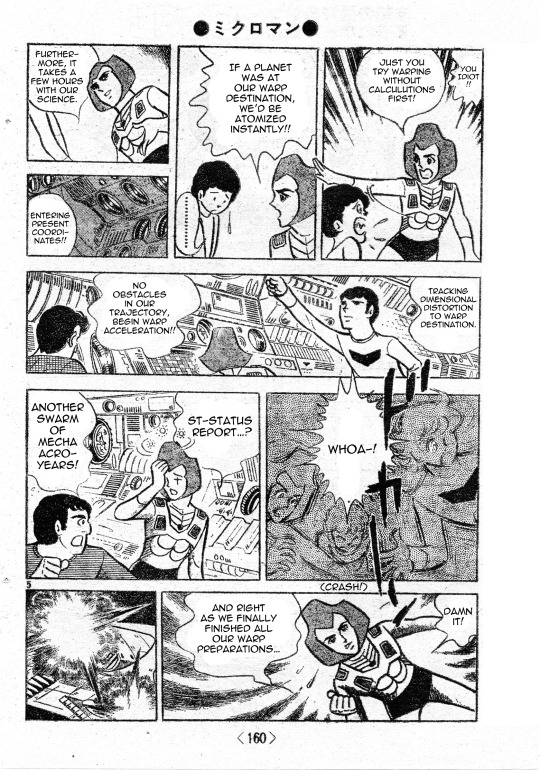
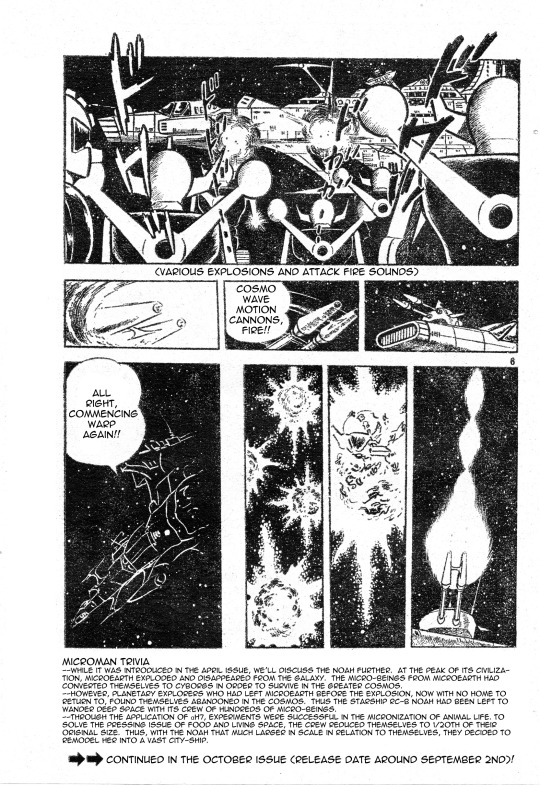
While it was introduced in the April issue, we’ll discuss the Noah further. At the peak of its civilization, MicroEarth exploded and disappeared from the galaxy. The Micronians from MicroEarth had converted themselves to cyborgs in order to survive in the greater cosmos.
However, planetary explorers who had left MicroEarth before the explosion had found themselves with no home to return to, orphaned in the cosmos. Thus it was that the starship RC-B Noah had been left to wander deep space with its crew of hundreds of Micronians.
((Tette Hakase: The Noah was to be released under the “RC-B Noah” trademark. It would seem that “RC-B” would mean “Radio Control Base”, but given that it was slated for release around the time of “The Super Control Arcadia” and “Super Control R2-D2”, it may actually have been similarly operated with ultrasonic waves. The remote control functions would have included: forward, turn right, turn left, stop, launch missiles, and rotate the radar dish.))
Through the application of αH7, experiments were successful in the micronization of animal life. Then, to solve the pressing issue of food and living space, the crew reduced themselves to 1/20th of their original size. Thus, with the Noah that much larger in scale to themselves, they decided to remodel her into a vast city-ship.
The RC-B Noah is capable of warp navigation. It detects dimensional distortions in space and warps through them into sub-space to re-emerge from other distortions at the destination. If the state of the distortions at the destination are not calculated accurately, it can be very dangerous, so warps are always only made to ranges that are calculable.
Chapter 33: October, 1978
Where did the Police Keepers come from? When the comet which had appeared in the vicinity of Jupiter reached Earth, the Micromen here detected an αH7 reaction from the comet. The Transfer Fortress mobilized immediately to investigate.
The nucleus of the comet surrounded by its cloud of fine particles was a frozen world. A part of the icy surface suddenly began to glow with a pale light, and then shattered as new allies emerged. They had come to help defend the Earth.
With their help, the micro-city construction project, known as Build Project, was able to advance far more rapidly. The Build Base would be completed ahead of schedule thanks to their own contribution of the Build Crane. Construction then commenced of the Build Lancer as a means of transportation. But there were also those who viewed the renewed prosperity of the Micromen as most unpleasant. One in particular was Arden, emissary of evil, who came to Earth unsatisfied with the Acroyears’ lack of progress. The nature of his robot-type spaceship, Arden Robo, remains unclear for now.
Chapter 34: November, 1978
The Build Base became known as “Build House”: Unlike the bases up until now, it included living facilities for the Micromen to reside in on Earth, not unlike a human apartment complex. However, while apartment-like in appearance, in order to always be able to defend against Acroyears and Arden, as well as participate in disaster relief, new weapons were incorporated into its design, and it can change its formation during states of emergency.
The production method, known as “pre-fabrication,” uses factory-produced panels which are assembled at the location using special joints. It is similar to the construction methods used I making human skyscrapers, but substitutes plastic for concrete.
Aside from the built-in crane, the panels are also lifted using the Build Crane. Climb Leader can be used to carry the crane. The Build Bases are constructed at various sites, but the configuration may vary based on their assignment and on the local environment.
Chapter 35: December 1978




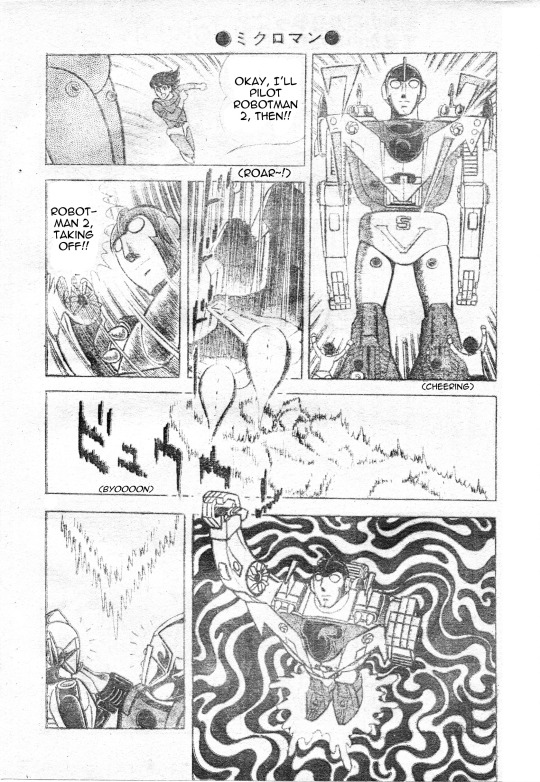
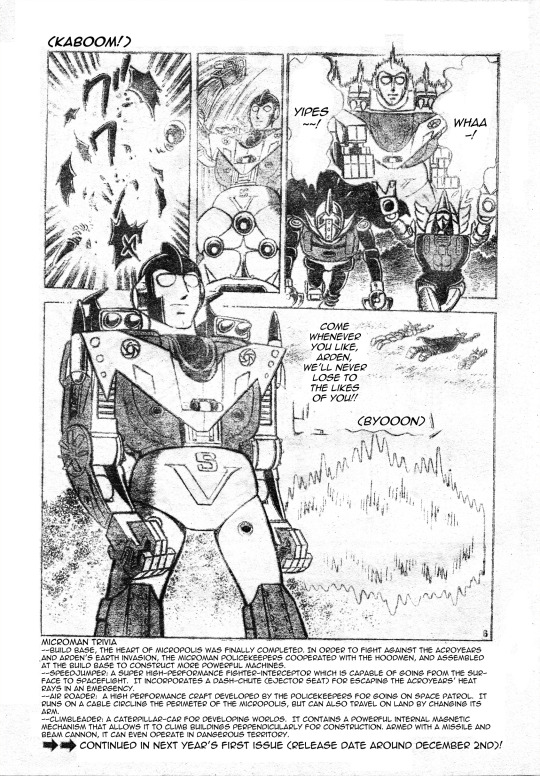
Build Base, the heart of Micropolis、 was finally completed. In order to fight against the Acroyears and Arden’s Earth invasion, the Microman PoliceKeepers cooperated with the Hoodmen, and assembled at the Build Base to construct more powerful machines.
SpeedJumper: a super high-performance fighter-interceptor which is capable of going from the surface to spaceflight. It incorporates a Dash-Shoot (ejector seat) for escaping the Acroyears’ heat rays in an emergency.
Air Roader: a high performance craft developed by the PoliceKeepers for going on space patrol. It runs on a cable circling the perimeter of the Micropolis, but can also travel on land by re-positioning its arm.
ClimbLeader: a caterpillar-car for developing worlds. It contains a powerful internal magnetic mechanism that allows it to climb buildings perpendicularly for construction. Armed with a missile and beam cannon, it can even operate in dangerous territory. (Continued in Year Four...coming later)
#microman#Micronauts#Hoodman#Police Keeper#takara sf land#microman command#ミクロマン#build project#micropolis#新宅よしみつ#冒険王#フードマン#ポリスキーパー#ミクロマンコマンド#ビルド計画
12 notes
·
View notes
Text
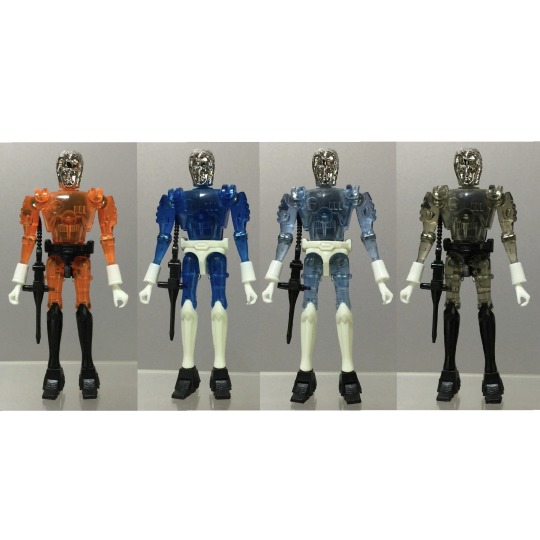


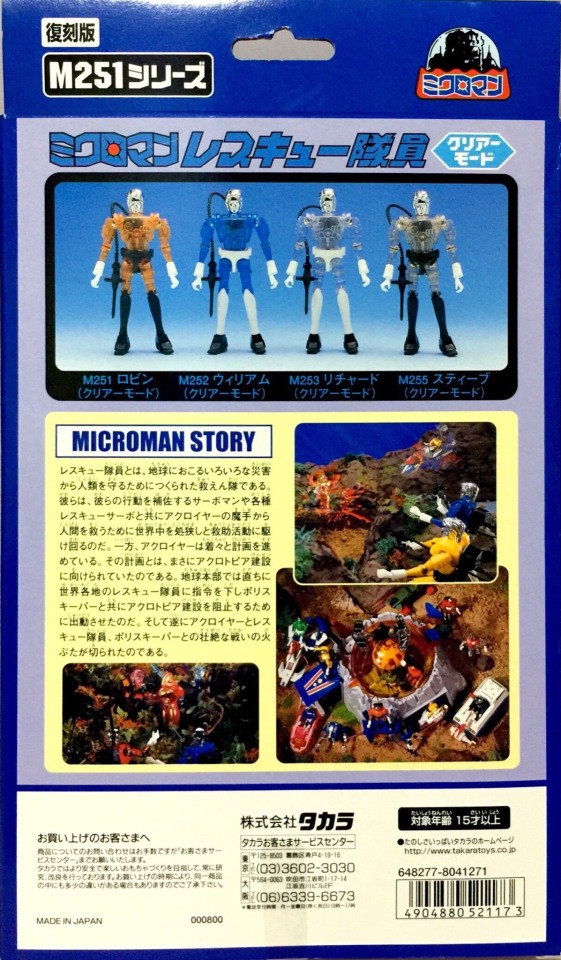
復刻版 ミクロマン レスキュー隊員 クリアーモード トイザらス限定
□M251 ロビン(クリアーモード)
□ M252 ウィリアム(クリアーモード)
□ M253 リチャード(クリアーモード)
□M255 スティーブ(クリアーモード)
2000年9月8日発売

MICROMAN STORY
レスキュー隊員とは、地球におこるいろいろな災害から人類を守るためにつくられた救えん隊である。彼らは、彼らの行動を補佐するサーボマンや各種レスキューサーボと共にアクロイヤーの魔手から人間を救うために世界中を処狭しと救助活動に駆け回るのだ。一方、アクロイヤーは着々と計画を進めている。その計画とは、まさにアクロトピア建設に向けられていたのである。地球本部では直ちに世界各地のレスキュー隊員に指令を下しポリスキーパーと共にアクロトピア建設を阻止するために出動させたのだ。そして遂にアクロイヤーとレスキュー隊員、ポリスキーパーとの壮絶な戦いの火ぶたが切られたのである。
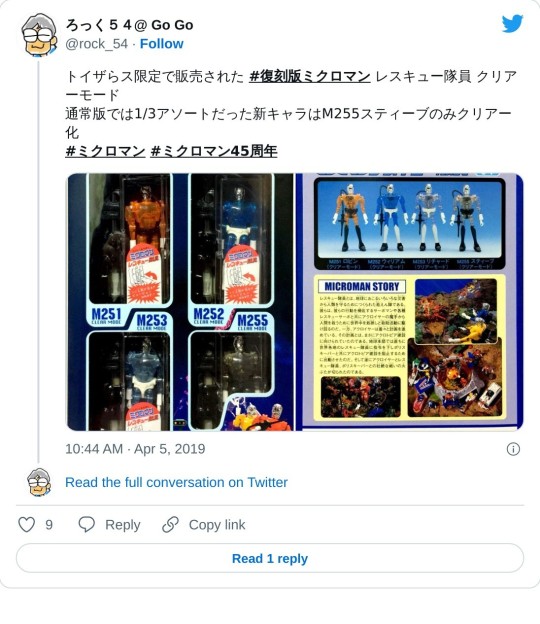
3 notes
·
View notes
